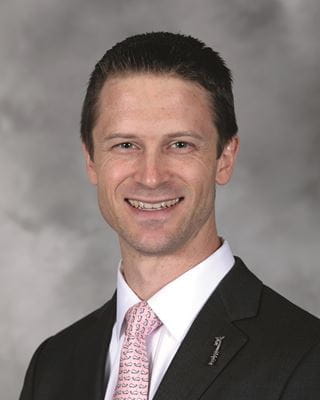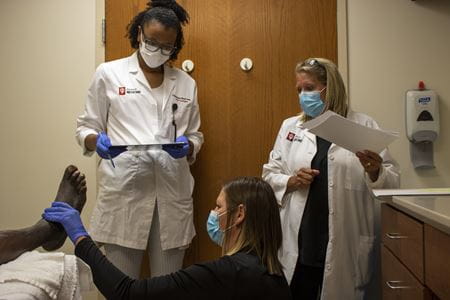
“Indiana, unfortunately, has a high rate of patients undergoing amputations; one of the highest in the United States,” said Gregory G. Westin, MD, assistant professor of surgery. “Looking at other areas of the country and the world that have tried to work on this problem, one of the best ways to improve outcomes is by bringing together resources from throughout the university and the health system.”
People with severe or chronic wounds can benefit from the expertise of multiple specialties, but in many cases, they do not receive these specialty consultations. Even when they do see multiple specialists, including physical therapists, wound specialists, and surgeons, often these specialists are not in one centralized location and may not have easy access to information from the other specialties.
Dr. Westin explained that one of the things that drew him to IU School of Medicine was the coordinated effort between the surgery department, the Indiana Center for Regenerative Medicine and Engineering, and IU Health to help create the Comprehensive Wound Care Center (CWC). The CWC is a center that helps bring together all the specialties that can help patients avoid the trauma of losing a limb.
“Having the Comprehensive Wound Care Center helps us build connections between all these areas that all have an interest in limb preservation,” said Dr. Westin. “Having everything under one roof means that when I see a patient who has a problem with blood flow to their foot, right next door is a podiatrist, and we can discuss concerns with the patient together.”
The Limb Preservation program also allows for learning opportunities for residents and faculty, as they work side-by-side with other specialists.
“The traditional model of education that we are trained in is about learning a specialty. For example, I’m a blood vessel specialist, so I have extensive knowledge about problems with blood flow and how to fix them, whether with medicines, surgeries, or minimally invasive catheter-based therapies. However, traditional training might not include a good education in how to work on managing wound care, advanced prosthetics or custom footwear, or infectious diseases,” said Dr. Westin. “I think it is very important for the next generation of limb preservation to give these young medical students, residents, fellows, and other trainees an idea of how a comprehensive system works and how interconnected our different specialties are.”
One other benefit that the program brings is giving a resource to medical professionals who are working in remote locations throughout Indiana, where they might not have all the resources or specialists.
Dr. Westin explained that having a comprehensive team in one location makes it easier for doctors to refer patients to the Limb Preservation Program in the Comprehensive Wound Care Center at IUH Methodist Hospital, knowing that patients will have easy access to all the different specialists.
The goal of the center is to lower the ever-growing number of amputations happening in Indiana and to give hope to those who may be faced with the difficult prospect of possibly losing a limb due to injuries or health issues.
“Ultimately my goal is that we, first of all, dramatically lower the rate of amputation in Indiana. Second, we are working to improve care for patients at risk of limb loss so that they are able to spend more time without pain, able to walk more easily, and able to spend less time in hospitals and more time doing the things that they love,” said Dr. Westin. “Indiana University is poised to do all of this well, using the CWC as a central hub both for excellent clinical care and as a site of research.”
Dr. Westin explained that every patient who walks in the door with a risk of amputation is offered the opportunity to help in ongoing research, whether that is researching a new medical therapy, wound care method or product, or type of surgery.
“As much as we do know about helping people with wounds, there are so many areas in which we have room to learn more. As long as we continue to have people suffering amputations or living with chronic wounds, we will have room for improvement. There is so much more to study about how to prevent amputation and how best to improve these patients’ lives. The amazing resources at Indiana University, including advanced basic and clinical scientific research, subspecialist experts in areas from reconstructive surgery to wound care, and a network of care throughout the state, give us a place to start.”
